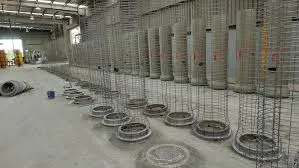Sep . 06, 2024 05:04 Back to list
High-Quality Ductile Iron Castings for Reliable Performance
Ductile Iron Castings An Overview
Ductile iron castings, also known as nodular castings or spheroidal graphite iron, have gained significant popularity in the manufacturing and engineering sectors due to their excellent mechanical properties and versatility in application. Developed in the 1940s, ductile iron emerged as a revolutionary material, combining the benefits of cast iron with enhanced ductility and strength. This article explores the characteristics, production methods, benefits, and applications of ductile iron castings.
Characteristics of Ductile Iron
Ductile iron is characterized by its unique microstructure, which consists of spherical graphite inclusions embedded in a matrix of ferrite or pearlite. This structure is what grants ductile iron its superior tensile strength and ductility compared to traditional cast iron. Typical ductile iron castings can exhibit tensile strength ranging from 60,000 psi to over 120,000 psi, alongside elongation percentages that can reach around 10% to 25%. These properties make ductile iron an ideal choice for applications that require tough and durable materials.
Production Methods
The production of ductile iron castings involves several steps that are crucial for achieving the desired properties
. The process begins with the melting of raw materials, predominantly pig iron, scrap metal, and alloying elements. The addition of a small amount of magnesium, typically in the form of ferrosilicon magnesium, during the melting process is what transforms the graphite from a flake shape (as seen in gray cast iron) to a spheroidal shape, leading to the formation of ductile iron.Once the molten metal is prepared, it is poured into molds to create the desired shapes, followed by cooling and solidification. Heat treatment processes, such as annealing and quenching, may also be applied to enhance specific properties or achieve particular hardness levels. The resulting castings are further machined and finished to meet the precise tolerances required by various industries.
ductile iron castings

Benefits of Ductile Iron Castings
The advantages of ductile iron castings are numerous. Firstly, they possess excellent wear resistance, making them suitable for heavy-duty applications such as automotive components, industrial machinery, and piping systems. Additionally, ductile iron exhibits good corrosion resistance when treated appropriately, enhancing its longevity in harsh environments.
Another significant benefit is the ease of machining. Ductile iron can be easily cast and machined into complex shapes, allowing for intricate designs that are still robust and reliable. Moreover, when compared to steel, ductile iron castings can be produced at a lower cost, making them an economically viable option for manufacturers.
Applications in Various Industries
Ductile iron castings are utilized in a wide range of industries due to their superior properties. In the automotive sector, they are commonly used for engine blocks, crankshafts, and suspension components. The construction industry employs ductile iron for pipes, drainage systems, and manhole covers. Furthermore, these castings are essential in manufacturing heavy equipment and machinery in sectors such as mining and agriculture.
Conclusion
In summary, ductile iron castings offer an exceptional combination of strength, ductility, and versatility, which makes them indispensable in various industrial applications. As technology advances and the demand for high-performance materials continues to grow, the role of ductile iron castings is likely to expand even further, solidifying their position as a cornerstone material in modern manufacturing.
-
Durable Centrifugally Cast Iron Water Main Pipe
NewsAug.11,2025
-
Centrifugally Cast Iron Water Main Pipes for Reliability
NewsAug.10,2025
-
High-Quality Centrifugally Cast Iron Water Main Pipes
NewsAug.09,2025
-
Durable Cast Iron Water Main Pipe & Drainage Solutions
NewsAug.08,2025
-
Buy Cast Iron Pipe: Premium Ductile Iron & Drain Solutions
NewsAug.07,2025
-
Durable Cast Iron Water Main Pipe | Buy Ductile Pipe
NewsAug.06,2025


